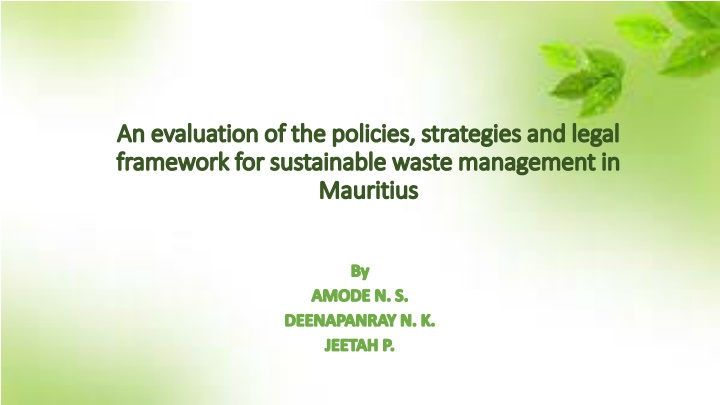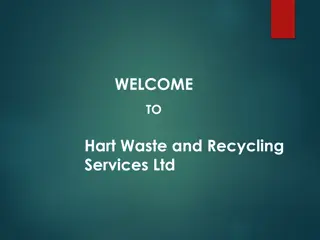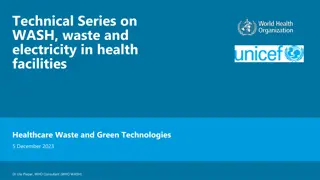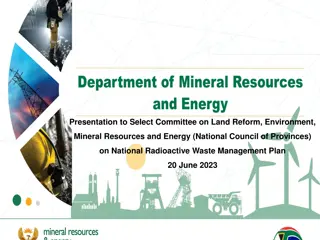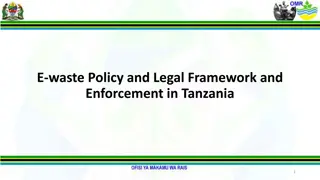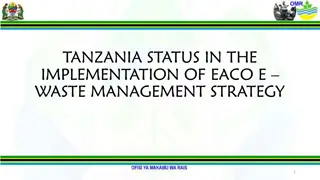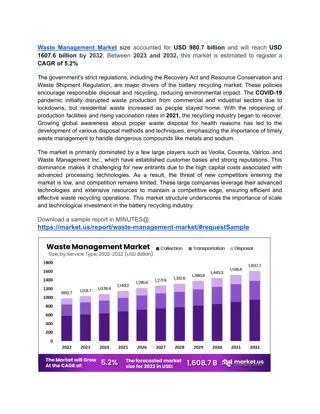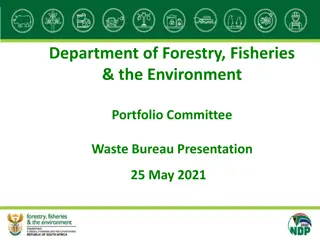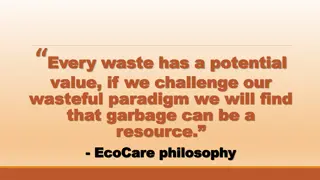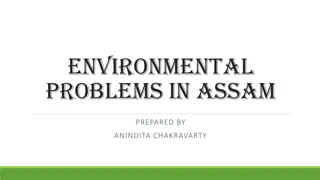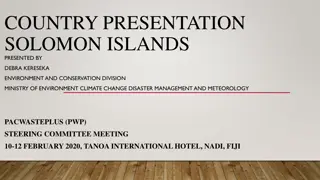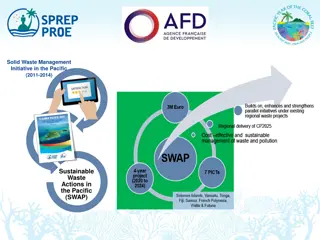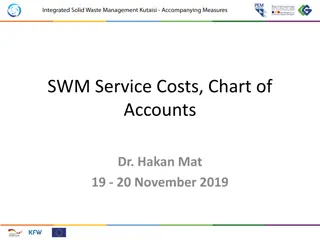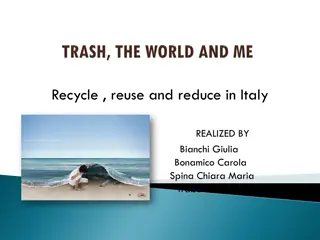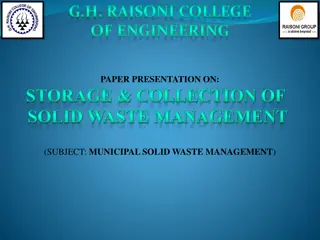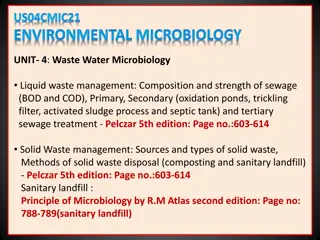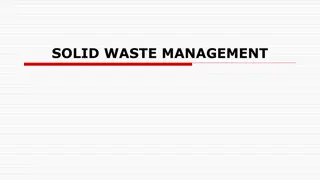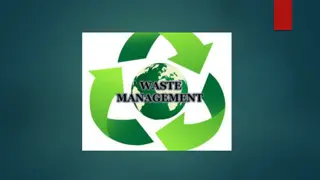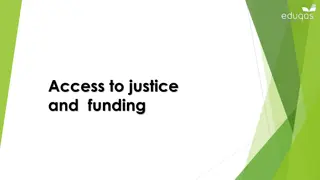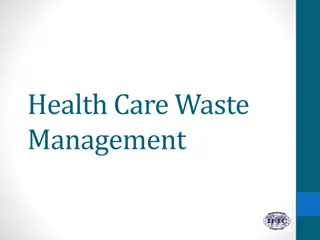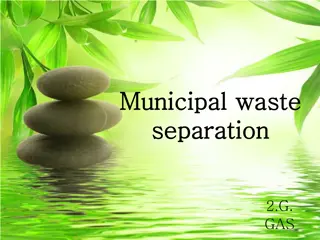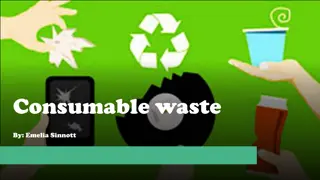An Evaluation of Policies and Legal Framework for Sustainable Waste Management in Mauritius
This research delves into the policies, strategies, and legal framework governing sustainable waste management in Mauritius. It highlights challenges faced, including waste generation rates and composition, and proposes solutions for a more sustainable approach.
Download Presentation

Please find below an Image/Link to download the presentation.
The content on the website is provided AS IS for your information and personal use only. It may not be sold, licensed, or shared on other websites without obtaining consent from the author.If you encounter any issues during the download, it is possible that the publisher has removed the file from their server.
You are allowed to download the files provided on this website for personal or commercial use, subject to the condition that they are used lawfully. All files are the property of their respective owners.
The content on the website is provided AS IS for your information and personal use only. It may not be sold, licensed, or shared on other websites without obtaining consent from the author.
E N D
Presentation Transcript
An evaluation of the policies, strategies and legal An evaluation of the policies, strategies and legal framework for sustainable waste management in framework for sustainable waste management in Mauritius Mauritius By AMODE N. S. DEENAPANRAY N. K. JEETAH P.
Overview Introduction Methodology Results & Discussions Conclusion References
Introduction Introduction
World Bank projects annual rise of 70% in waste generation rate from 2016-2050 Unsustainable waste management is causing global apprehension social and environmental constraints impeding sustainable development Fragility of ecosystems Scarcity of resources Quasi-isolation from economic poles More concerning for SIDS => waste generation per capita is 48% higher than global mean Lack of focus on solid waste governance factors Challenging to attain sustainable waste management Lack of adequate policies and comprehensive and specific legal framework
Overview of the study area: Waste generation in the Island of Mauritius Others 6% African SIDS with a population of 1,219,187 Plastic 14% Yard 27% generates around 494,073 tons of waste, out of which 54% is organic waste Paper 14% Glass 3% facing increasing challenges related to SWM as its sole sanitary landfill is approaching saturation Metal 3% Textile 6% Food 27% waste generation per capita in Mauritius has increased by 696% in a span of 24 years Figure 1: Composition of Municipal solid waste in Mauritius (Adapted from: Ministry of Environment, Solid Waste Management and Climate Change, 2020)
Overview of the study area: Waste generation in the Island of Mauritius 0.5 Figure 2: Waste Generation per capita for the Island of Mauritius from 1998 to 2020 (Adapted from: Mohee et al., 2009, Central Statistics Office, Republic of Mauritius(2008), Central Statistics Office, Republic of Mauritius(2009), Statistics Mauritius (2011, 2012,2013,2015,2016,2017,2018,2020,202 1, 2023),Beerachee (2012)) Annual Per Capita Waste Generation (Tonnes) 0.4 0.3 0.2 0.1 0 1995 2000 2005 2010 Year 2015 2020 2025 Reasons for staggering increase: improved standard of living, economic progress, including tourism Ministry of Environment, Solid Waste Management and Climate Change of the Republic of Mauritius plans to divert 70% of waste from the landfill through reducing, reusing, recovery and recycling but currently only 3% waste is being diverted from landfill Ministry acknowledges that the inadequacy of legal framework is an issue and describes current laws as being outdated and uncomprehensive in its Annual Report for FY 2021-2022
Aim & Objectives Aim: Using case of the SIDS of Mauritius to evaluate the efficacy of policies, strategies and legislative framework in the solid waste management system in view of providing a possible mechanism to attain the goals of a sustainable waste management framework Using existing solid waste governance indicator, namely, Adequacy of national framework for solid waste management of the Wasteaware Benchmark Indicators, to identify potential gaps and the extent to which the strategies and legal framework align with the concept of sustainability Suggesting improvement areas to curb the identified weaknesses
Methodology Methodology
Use of the Wasteaware Benchmark Indicator adequacy of national framework for solid waste management developed by Wilson et al. (2015) Evaluates the level to which the national management framework is befitting for the country Measures the extent of implementation the indicator allow the use of existing data for the evaluation process and the need for primary data collection is eliminated Applicable for both developing and developed countries
ADEQUACY OF NATIONAL FRAMEWORK FOR SOLID WASTE MANAGEMENT National Institution responsible for policy Determines if there is a single National Institution responsible to implement or coordinate implementati on of SWM policies/strate gy Regulatory control/enforce ment Guidelines and implementation procedures Legislation and regulations EPR or PS Strategy/policy Analyses availability of legislation dedicated only to solid waste management and measures extent to which this legislation has been implemented Evaluates existence of clear guidelines for enforcement of laws and implementatio n of the strategy and oversees mechanism for facility siting Analyses existence of a mechanism to engage with product manufacturers to share the cost of management of waste at end-of-life Evaluates the availability of an environmental regulator with proper organization and resources to enforce regulations Assesses if there are clear policies and a national strategy for solid waste management and if these are being implemented
Evaluation of sub-indicators done through secondary data collection process in three phases: Phase 1: Analysis of regulatory frameworks related to waste management in Mauritius Phase 2: Analysis of formal documents (annual reports, NDC, other publications by governmental bodies) related to action plans and waste management strategies or other strategies, which encompass solid waste Phase 3: review of scientific publications, press articles and reports from formal organizations like the UN, European Commission to ensure an unbiased and holistic overview Each sub-indicator under Adequacy of national framework for solid waste management is assigned a score (between 0 and 20, 0 = no compliance, 5 = low compliance, 10 = medium compliance, 15= medium/ high compliance , 20 = high compliance ) as per the User Manual for Wasteaware ISWM Benchmark Indicators by Wilson et al. (2015). Mean of scores of each sub-indicator provides the overall score for adequacy of national framework for solid waste management and final compliance level (LOW, LOW/MEDIUM, MEDIUM, MEDIUM/HIGH, HIGH) determined as per the User Manual for Wasteaware ISWM Benchmark Indicators by Wilson et al. (2015).
Results and Discussions Results and Discussions
Results and Discussions: sub-indicator 1: Legislation and Regulations Score of 5/20 = LOW compliance Strength: The Waste Management and Resource Recovery Act 2023 enacted in April 2023 but not enforced as of December 2023 Weakness: Currently, applicable waste management regulations are scattered in several regulations made under the Environment Protection Act 2002 Weakness: Another regulation related to waste segregation at source has not yet been finalized. The need to draft an additional legislative framework to complement the existing one proves that the latter does not cater for adequate implementation of waste recovery through source segregation in Mauritius Weakness: New Act dedicated to waste does not adequately accommodate changes in national situations since it excludes energy recovery from waste, which forms part of the strategy Remedial Measures: Model Waste Dedicated regulations and implementation based on best practices of other countries: Eg Germany s comprehensive Waste Management Act which was successfully implemented following awareness campaigns
Results and Discussions: sub-indicator 2: Strategy Policy Score of 20/20 = HIGH compliance Strength: Well-defined strategies in place: Roadmap for waste management in line with the NDC, the Roadmap and Action Plan for a Circular Economy in the Republic of Mauritius Strength: Government approved strategies with actions to be undertaken within a specific time frame and are actively in phase of implementation Strength: Strategies are subject to updates based on outcomes of feasibility studies
Results and Discussions: sub-indicator 3: Guidelines and implementation procedures Score of 10/20 = MEDIUM compliance Strength: Guidelines set out in PART V and PART VI of the Waste Management and Resource Recovery Act (not yet promulgated) to implement national strategy Strength: action plans in place outlining steps to be followed with regular monitoring of the level of achievement of objectives in strategy Weakness: No guidelines in place to specify on which basis siting of waste management facilities will be done as per the Roadmap. EIAs have to be submitted for setting up of landfills, transfer stations and incineration plants, no clear provision for AD units, composting plants or sorting units. Weakness: No mechanism available to collect views of local residents for setting up of composting plants, AD units or sorting units. EPA (2002) makes provision for public comments only for setting up of landfills, transfer stations and incineration plants. Weakness: no guideline or legal provision to prevent NIMBY syndrome and avoid siting of facilities is not done in poorest regions Remedial Measures: Implementation of guidelines for EIAs to include all waste management methods as specified in strategies, collection of views of inhabitants for siting, setting guidelines to ensure environmental justice and equity for waste management facility siting (eg use of GIS to monitor exposure levels, compensation to those in areas where waste facilities located, progressive siting)
Results and Discussions: sub-indicator 4: National Institution responsible for policy Score of 10/20 = MEDIUM compliance Strength: Solid Waste Management Division currently responsible for policy implementation Strength: Staffed with adequately qualified individuals Weakness: No separation of function for policy implementation and regulation enforcement Weakness: technical unit of SWMD is understaffed, the Waste Management and Resource Recovery Act 2023 (not yet enforced) specifies the setting up of a new Department of Waste Management and Resource Recovery, whose staffing will be time consuming once the Act is proclaimed due to economic obstacles Remedial Measures: Single national entity to oversee implementation of policies/strategy which is separate from the regulator. Ensure timely recruitment of adequately qualified staff through capacity building and approaching donors for funding.
Results and Discussions: sub-indicator 5: Regulatory control / enforcement Score of 15/20 = MEDIUM/HIGH compliance Strength: Solid Waste Management Division adequately enforces currently applicable regulations through the Technical Enforcement Unit Strength: High waste collection rates (100%), adequate registration of waste carriers, scavenging contractors and recyclers, monitoring of operators with an EIA license through site visits, issuing of contraventions in cases of non-compliances Weakness: Higher score not provided since waste dedicated regulation is yet to be enforced Remedial Measures: Ensure enforcement of upcoming regulations dedicated to waste management
Results and Discussions: sub-indicator 6: Extended Producer Responsibility (EPR) or Product Stewardship (PS) Score of 5/20 = LOW compliance Strength: Draft regulation in place for EPR (not yet enforceable). Roadmap and Action Plan for Circular Economy in the Republic of Mauritius makes provision for conducting a feasibility study to enable implementation of EPR for packaging by 2025 and specifies scheduling of conference on EPR to increase insight of business community on the subject. Weakness: No enforceable regulations for EPR or PS and draft EPR regulations currently covers only electrical and electronic waste. No concrete action has been undertaken yet for EPR. Remedial Measures: Finalize the draft regulations on EPR so that it can be enforced, consider inclusion of other types of waste (packaging as per the Roadmap) in EPR and PS regulations.
OVERALL SCORE: 54% (MEDIUM COMPLIANCE LEVEL) Legislation and regulations 20 15 EPR or PS Strategy/policy 10 5 0 Regulatory control/enforcement Guidelines and implementation National Institution responsible for policy Figure 3: overall score for Adequacy of national framework for solid waste management As per the online Wasteaware Platform of the University of Leeds (2009 data), this indicator scored 0%, representing NO compliance level Considerable improvement over the past 14 years, however, the previous study used data for only 1 urban location, which might not be very representative of the entire dynamics of the adequacy of national framework for solid waste management in Mauritius
Conclusion Conclusion
Mauritius has implemented some measures to strengthen its strategies, policies and legal framework for solid waste management but there is room for improvement Main Weaknesses: Main Strengths: Legislation dedicated to solid waste management not yet enforceable and does not cater for all methods mentioned in strategies the existence of a government approved national strategy aligned with the concept of sustainability Lack of adequate framework for EPR and PS availability of a single National entity to oversee policy implementation No mechanism to ensure environmental justice and equity when it comes to waste facility siting Adequate enforcement of currently applicable regulations Improvement required in terms of: implementing waste regulations through sensitization campaigns and other incentives establishing new regulations to cater for all methods planned in the strategies inclusion of more types of products in EPR draft regulations before finalization entrusting duties of policy implementation and regulation enforcement to separate entities drafting guidelines/regulations for waste facility siting to ensure equity
References Environment Protection Act, 2002. Environment Protection Act, Act 19 of 2002 5 September 2002 (unless otherwise indicated) [online]. Available from: https://environment.govmu.org/Documents/Legislations/A.%20Acts/1(i)Consolidated%20Environment%20Protection%20Act%202002.pdf [Accessed on: 10/02/2022]. Republic of Mauritius, 2023. Roadmap and Action Plan for a Circular Economy in the Republic of Mauritius [online]. Available from: https://circulareconomy.govmu.org/circulareconomy/wp-content/uploads/2023/08/Roadmap-and-Action-Plan-for-a-Circular-Economy-in-the- Republic-of-Mauritius-Final-report.pdf [Accessed on: 19/10/2023] Waste Management and Resource Recovery Act 2023. The Waste Management And Resource Recovery Act 2023, legal supplement to the Government Gazette of Mauritius No. 32 of 20 April 2023 [online]. Available from: https://mauritiusassembly.govmu.org/mauritiusassembly/wp- content/uploads/2023/04/act0323.pdf [Accessed on: 09/09/2023] Ministry of Environment, Solid Waste Management and Climate Change, 2022. Nationally Determined Contribution Action Plan for the Republic of Mauritius 2021 2030 [online]. Available from: https://environment.govmu.org/DocumentsList/Nationally%20Determined%20Contribution%20(NDC)%202021-2030.pdf [Accessed on: 19/10/2023] Ministry of Environment, Solid Waste Management and Climate Change, 2020. Ministry of Environment, Solid Waste Management and Climate Change [online] Available from: https://environment.govmu.org/Pages/Index.aspx [Accessed on: 26/06/2022]. Mohee, R., 2002. . Assessing the recovery potential of solid waste in Mauritius. , 36(1), 33 43. doi:10.1016/s0921-3449(02)00011-3 Republic of Mauritius (2020) The Climate Change Act 2020, Government Gazette of Mauritius No. 145 of 28 November 2020. Statistics Mauritius, 2021. Annual Digest https://statsmauritius.govmu.org/Documents/Statistics/By_Subject/Other/MIF/MIF_Yr20_300821.xlsx [Accessed on: 12/06/2022]. of Statistics 2020 [online]. Available from: University of Leeds, ND. Wasteaware Cities Indicators [online]. Available from: http://wabi.wasteaware.org/ [Accessed on: 24/06/2022]. Wilson, David C.; Rodic, Ljiljana; Cowing, Michael J.; Velis, Costas A.; Whiteman, Andrew D.; Scheinberg, Anne; Vilches, Recaredo; Masterson, Darragh; Stretz, Joachim; Oelz, Barbara, 2015. Wasteaware benchmark indicators for integrated sustainable waste management in cities. Waste Management, 35(), 329 342. doi:10.1016/j.wasman.2014.10.006 https://eprints.whiterose.ac.uk/85319/9/Wilson_et_al_Supplementary_information_Wasteaware_ISWM_Benchmark_Indicators_User_Manual_FINAL. pdf ; supplementary material:
Thank you for your kind Thank you for your kind attention attention
